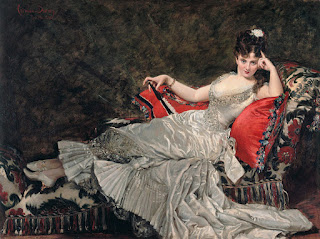Caspar David Friedrich's Unity of Thought and Vision
Looking at Caspar David Friedrich's paintings I am awed by his ability to embody abstract thought in a visual expression.
 In The Stages of Life Friedrich contemplates how human beings can mentally project the course of our lives in the form of the concepts of "future" and "distance." In order to embody these concepts visually, he integrates them with the physical attributes of distance: the diminution of size and fading away of detail.
In The Stages of Life Friedrich contemplates how human beings can mentally project the course of our lives in the form of the concepts of "future" and "distance." In order to embody these concepts visually, he integrates them with the physical attributes of distance: the diminution of size and fading away of detail.
In contrast to the detailed description and dark tonality of the foreground, Friedrich's ships sink away into a dreamy atmosphere of orange and blue. To integrate his projection of distance with its thematic meaning, Friedrich devised the method of echoing the arc created by the overall grouping of the ship's masts with the arced shape of the group of figures in the foreground. By presenting these characters at different ages Friedrich is telling the viewer outright that his projection of ships into the distance is a metaphor for the course of a man's life. The flash of brilliant blue across the water and the yellow fire of the fading sunset suggest that the future can be an exciting destination.
By integrating visual attributes with a conceptual meaning Friedrich has created a unique, never-before-seen stylization of our sense of sight. As Ayn Rand writes in The Romantic Manifesto:
* * *
An interesting aside about the title: "The Stages of Life" is a common iconography in the history of art (usually presented with a skull signifying death).
 In The Stages of Life Friedrich contemplates how human beings can mentally project the course of our lives in the form of the concepts of "future" and "distance." In order to embody these concepts visually, he integrates them with the physical attributes of distance: the diminution of size and fading away of detail.
In The Stages of Life Friedrich contemplates how human beings can mentally project the course of our lives in the form of the concepts of "future" and "distance." In order to embody these concepts visually, he integrates them with the physical attributes of distance: the diminution of size and fading away of detail.In contrast to the detailed description and dark tonality of the foreground, Friedrich's ships sink away into a dreamy atmosphere of orange and blue. To integrate his projection of distance with its thematic meaning, Friedrich devised the method of echoing the arc created by the overall grouping of the ship's masts with the arced shape of the group of figures in the foreground. By presenting these characters at different ages Friedrich is telling the viewer outright that his projection of ships into the distance is a metaphor for the course of a man's life. The flash of brilliant blue across the water and the yellow fire of the fading sunset suggest that the future can be an exciting destination.
By integrating visual attributes with a conceptual meaning Friedrich has created a unique, never-before-seen stylization of our sense of sight. As Ayn Rand writes in The Romantic Manifesto:
The sensory-perceptual awareness of an adult does not consist of mere sense data (as it did in his infancy), but of automatized integrations that combine sense data with a vast context of conceptual knowledge. The visual arts refine and direct the sensory elements of these integrations. By means of selectivity, of emphasis and omission, these arts lead man’s sight to the conceptual context intended by the artist. They teach man to see more precisely and to find deeper meaning in the field of his vision.Friedrich has certainly lived up to Ayn Rand's statement. He has taught us how to use our eyes to project the future as a glowing blue dream.
* * *
An interesting aside about the title: "The Stages of Life" is a common iconography in the history of art (usually presented with a skull signifying death).



Comments
Post a Comment